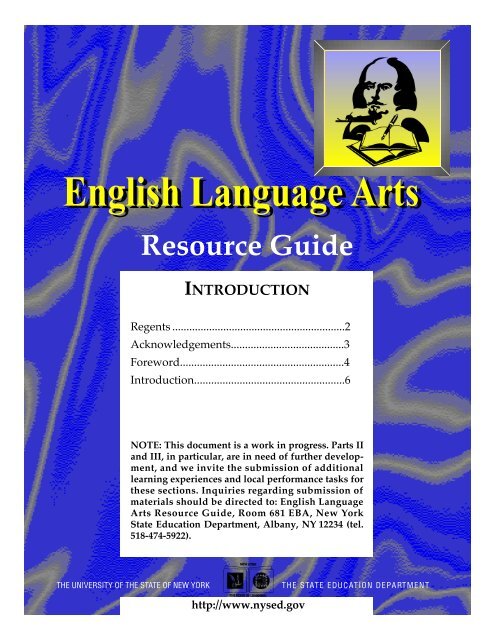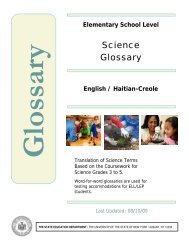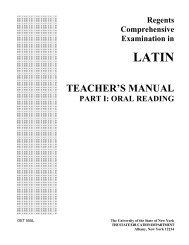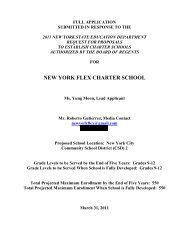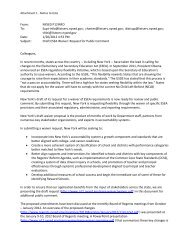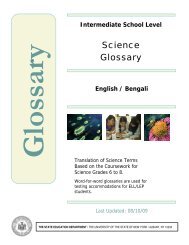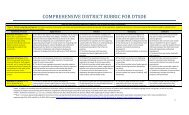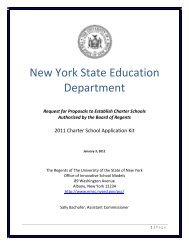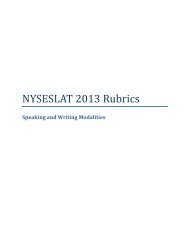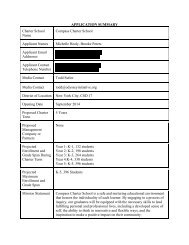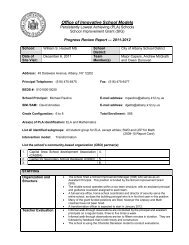English Language Arts - p-12 - New York State Education Department
English Language Arts - p-12 - New York State Education Department
English Language Arts - p-12 - New York State Education Department
You also want an ePaper? Increase the reach of your titles
YUMPU automatically turns print PDFs into web optimized ePapers that Google loves.
<strong>English</strong> <strong>Language</strong> <strong>Arts</strong><br />
THE UNIVERSITY OF THE STATE OF NEW YORK<br />
Resource Guide<br />
INTRODUCTION<br />
Regents .............................................................2<br />
Acknowledgements........................................3<br />
Foreword..........................................................4<br />
Introduction.....................................................6<br />
NOTE: This document is a work in progress. Parts II<br />
and III, in particular, are in need of further development,<br />
and we invite the submission of additional<br />
learning experiences and local performance tasks for<br />
these sections. Inquiries regarding submission of<br />
materials should be directed to: <strong>English</strong> <strong>Language</strong><br />
<strong>Arts</strong> Resource Guide, Room 681 EBA, <strong>New</strong> Yo r k<br />
<strong>State</strong> <strong>Education</strong> <strong>Department</strong>, Albany, NY <strong>12</strong>234 (tel.<br />
518-474-5922).<br />
http://www.nysed.gov<br />
THE STATE EDUCATION DEPA RT M E N T
THE UNIVERSITY OF THE STATE OF NEW YORK<br />
Regents of The University<br />
CARL T. HAYDEN, Chancellor, A.B., J.D. ........................................................................... Elmira<br />
LOUISE P. MATTEONI, Vice Chancellor, B.A., M.A., Ph.D. ............................................... Bayside<br />
JORGE L. BATISTA, B.A., J.D............................................................................................... Bronx<br />
J. EDWARD MEYER, B.A., LL.B. ......................................................................................... Chappaqua<br />
R. CARLOS CARBALLADA, Chancellor Emeritus, B.S......................................................... Rochester<br />
NORMA GLUCK, B.A., M.S.W. .......................................................................................... <strong>New</strong> <strong>York</strong><br />
ADELAIDE L. SANFORD, B.A., M.A., P.D. ......................................................................... Hollis<br />
WALTER COOPER, B.A., Ph.D. ........................................................................................... Rochester<br />
DIANE O’NEILL MCGIVERN, B.S.N., M.A., Ph.D. ........................................................... <strong>State</strong>n Island<br />
SAUL B. COHEN, B.A., M.A., Ph.D................................................................................... <strong>New</strong> Rochelle<br />
JAMES C. DAWSON, A.A., B.A., M.S., Ph.D. .................................................................... Peru<br />
ROBERT M. BENNETT, B.A., M.S. ...................................................................................... Tonawanda<br />
ROBERT M. JOHNSON, B.S., J.D. ........................................................................................ Lloyd Harbor<br />
PETER M. PRYOR, B.A., LL.B., J.D., LL.D. ....................................................................... Albany<br />
ANTHONY S. BOTTAR, B.A., J.D. ....................................................................................... Syracuse<br />
MERRYL H. TISCH, B.A., M.A. .......................................................................................... <strong>New</strong> <strong>York</strong><br />
President of The University and Commissioner of <strong>Education</strong><br />
RICHARD P. MILLS<br />
Executive Deputy Commissioner of <strong>Education</strong><br />
THOMAS E. SHELDON<br />
Deputy Commissioner for Elementary, Middle, Secondary, and Continuing <strong>Education</strong><br />
JAMES A. KADAMUS<br />
Assistant Commissioner for Curriculum, Instruction, Assessment, and Innovation<br />
EDWARD T. LALOR<br />
Coordinator of Curriculum and Instruction<br />
ROSEANNE DEFABIO<br />
Copyright © 1997 by <strong>New</strong> <strong>York</strong> <strong>State</strong> <strong>Education</strong> <strong>Department</strong>.<br />
The <strong>State</strong> <strong>Education</strong> <strong>Department</strong> does not discriminate on the basis of age, color, religion, creed, disability,<br />
marital status, veteran status, national origin, race, gender or sexual orientation in its educational pro g r a m s ,<br />
services and activities. Portions of this publication can be made available in a variety of formats, including<br />
braille, large print or audio tape, upon request. Inquiries concerning this policy of nondiscrimination should<br />
be directed to the <strong>Department</strong>’s Office for Diversity, Ethics, and Access, Room 152, <strong>Education</strong> Building,<br />
A l b a n y, NY 1 2 2 3 4 .<br />
<strong>English</strong> <strong>Language</strong> <strong>Arts</strong>
Acknowledgments<br />
Many <strong>State</strong> <strong>Education</strong> <strong>Department</strong> staff members have made significant contributions to the<br />
<strong>English</strong> <strong>Language</strong> <strong>Arts</strong> Resource Guide. Edward Lalor and Roseanne DeFabio originated the concept<br />
of the Resource Guides and served as primary motivating forces in its development.<br />
Jacqueline Marino, Patricia Webster, and Judith Golombiski reviewed and selected materials<br />
for inclusion in Parts I and III of the document and offered their subject area expertise to the<br />
overall document. Anne Schiano, Jeannette Canaday, and Virginia Hammer developed and<br />
coordinated the process used to request and review learning experiences from teachers across<br />
the <strong>State</strong>, many of which appear in Part II. Special thanks to Judith Rothstein, who served as the<br />
<strong>English</strong> language arts consultant/coach for Part II and who worked patiently and persistently<br />
with teachers to refine the learning experiences. John Maryanopolis, Jan Christman, Major<br />
Capers, and Patricia Mulligan contributed their creative and technical capabilities to the overall<br />
design of the Resource Guide. Edith Toohey served as the coordinating editor.<br />
Joseph McDonald and Judith Pelchat, from the Annenberg Insititute for <strong>Education</strong>al Reform<br />
at Brown University, Providence R.I., provided invaluable assistance in the development, implementation<br />
and refinement of the peer process used to review the learning experiences submitted<br />
by <strong>New</strong> <strong>York</strong> <strong>State</strong> teachers.<br />
Teachers from many schools and districts served as pioneers by submitting their work for<br />
review. Although the work of each of these teachers may not appear in this edition, all are commended<br />
for their contributions.<br />
Julie Amodeo Amy Heyman Patricia Walz<br />
Linda Ahlstedt Diane Knapp Melanie Weber<br />
Pat Barbanelle Susan Menkes<br />
Patricia Boucher Tina Morris<br />
Jessica Bayer Lenore Metter<br />
Charlotte Brummett Joy Miller<br />
Violet Burtula Nadine McDermott<br />
Frances Brewer Stephanie Needham<br />
Deborah Caddick Gail Nelli<br />
Patricia Chiodo Connie Noelle<br />
Patricia Clahassey Richard Nunziato<br />
Richard Comfort Shari O’Bryan<br />
Katy Coletti Kathy Oboyski-Butler<br />
Margaret Charboneau Mary Lou Papadopoulos<br />
Paula Costello Barbara Powell<br />
Linda Dagle Michael Saarie<br />
Joan Davidson Elise Scudder<br />
Kevin Dirth Jan Siebold<br />
Martha Evans Marie Sullivan<br />
Lou-Ellen Finter Kristine Tolmie<br />
Carol Gladstone Jessie Vance<br />
Laura Glista Theo Vandeventer<br />
Susan Goldberg Rachel VanSchiack<br />
Karen Henn Robert VonHunke<br />
Acknowledgments 3
Foreword<br />
<strong>New</strong> <strong>York</strong> <strong>State</strong> is engaged in a serious effort to raise standards for students. The strategy for<br />
raising standards, as clearly articulated by Commissioner Richard Mills, includes three elements:<br />
1. Setting clear, high expectations/standards for all students and developing an effective<br />
means of assessing student progress in meeting the standards;<br />
2. Building the local capacity of schools/districts to enable all students to meet standards;<br />
and<br />
3. Making public the results of the assessment of student progress through school<br />
reports.<br />
The learning standards approved by the Board of Regents reflect the intensive, collaborative<br />
work conducted over the past few years by the <strong>State</strong> <strong>Education</strong> <strong>Department</strong> and by national<br />
groups, such as the National Center for Restructuring <strong>Education</strong>, Schools and Teaching<br />
(NCREST), the Council of Chief <strong>State</strong> School Officers, and the <strong>New</strong> Standards Project.<br />
Learning standards have two primary dimensions. Content standards describe what students<br />
should know, understand and be able to do. Performance standards define levels of student<br />
achievement pertaining to content. However, the teaching and learning which takes place<br />
in between is the heart of the matter. This addressess opportunity to learn standards and is, perhaps,<br />
the most crucial element of the entire process.<br />
Classroom teachers have a tremendous challenge. They must bring reality to the teaching<br />
and learning process in order to assure that all of their students will perform at higher levels.<br />
They also have a wonderful opportunity for both professional and personal growth. Numberless<br />
occasions are available for teachers to really examine their instructional practice, to share what it<br />
is they do each day with their students, to work in collaboration with other teachers and students<br />
and, thereby, to grow in their understanding of the craft of teaching. In his book, Teaching:<br />
Making Sense of an Uncertain Craft (Teacher’s College Press,1992), Joseph McDonald states<br />
that:<br />
“Real teaching. . .happens inside a wild triangle of relations—among teachers,<br />
students, subject—and all points of the triangle shift continuously.”<br />
This Resource Guide has been developed to get inside this triangle and provide some clarity,<br />
to demonstrate concretely how colleagues across the state are tackling the job of standards-based<br />
teaching and learning, and to offer examples of resource/research materials which can serve to<br />
inform local curriculum development. The standards define the points of the triangle; they are<br />
the starting point. Assessments are simultaneously ends and beginnings; they serve both as<br />
benchmarks to ascertain what and how well students are learning and as springboards for further<br />
teaching and learning. Real teaching shifts continuously in response to the needs of students<br />
as they strive to understand the content and to demonstrate their understanding in a variety<br />
of assessment contexts.<br />
The Board of Regents recognizes the diversity of students in <strong>New</strong> <strong>York</strong> <strong>State</strong>, including<br />
students with disabilities, students with limited <strong>English</strong> proficiency, gifted students, and educationally<br />
disadvantaged students, and has made a strong commitment to integrating the education<br />
of all students into the total school program. The standards in the framework apply to all<br />
students, regardless of their experiential background, capabilities, developmental and learning<br />
4 <strong>English</strong> <strong>Language</strong> <strong>Arts</strong>
differences, interests, or ambitions. Aclassroom typically includes students with a wide range of<br />
abilities who may pursue multiple pathways to learn effectively, participate meaningfully, and<br />
work toward attaining the curricular standards. Students with diverse learning needs may need<br />
accommodations or adaptations of instructional strategies and materials to enhance their learning<br />
and/or adjust for their learning capabilities.<br />
The <strong>English</strong> <strong>Language</strong> <strong>Arts</strong> Resource Guide has been conceptualized using these philosophical<br />
bases. The content has been selected to address important aspects of the teaching and learning<br />
process. It is our hope that all the partners in all learning communities in <strong>New</strong> <strong>York</strong> <strong>State</strong> will<br />
find the document useful, practical and informative.<br />
Forword 5
<strong>English</strong> <strong>Language</strong> <strong>Arts</strong> Curriculum Resource Guide<br />
Introduction<br />
The <strong>English</strong> <strong>Language</strong> <strong>Arts</strong> Resource Guide is the first of a series of resource guides which are<br />
being designed to serve as companion documents to the Frameworks and the Learning<br />
Standards. Each resource guide is intended to (1) establish connections for administrators and<br />
teachers between these learning standards and the specifics of classroom instruction and to (2)<br />
provide further elaboration of the standards which will be of assistance in planning grade by<br />
grade curriculum. It is the hope of all those who worked on the development of this resource<br />
guide that teachers and students will find the support they need to give students the opportunity<br />
to learn and achieve.<br />
The guide has been developed with significant input from local districts, schools, and teachers<br />
who are currently working to align their instructional practices with the learning standards.<br />
The document is not comprehensive or exhaustive. Yet it provides teachers with a wealth of<br />
information, strategies, learning experiences, sample assessments, research, and specific discipline<br />
materials which can be used in the curriculum development process within each<br />
school/district.<br />
The <strong>English</strong> <strong>Language</strong> <strong>Arts</strong> Resource Guide is divided into three major sections:<br />
Part I: Planning a Standards-Based Curriculum: Curriculum Essentials<br />
The purpose of this section is to outline the elements considered essential in planning<br />
a standards-based <strong>English</strong> language arts curriculum. It contains such information as a<br />
description of key <strong>English</strong> language arts experiences, background information on<br />
such topics as literary genres, language functions, resources and literature suggestions<br />
from a variety of sources. Samples of locally developed curricula and scope and<br />
sequence materials are also included.<br />
Part II: Planning a Standards-Based Curriculum: Learning Experiences<br />
Standards-based learning experiences developed and reviewed by classroom teachers<br />
from across the state are presented in this section as examples of “real” activities that<br />
can be used to bring the learning standards to life in a classroom setting.<br />
Part III: Planning a Standards-Based Curriculum: Assessment Models<br />
Assessing student achievement of the learning standards is an on-going process. This<br />
section provides teachers with a variety of assessments which have been used in pilot<br />
situations, examples of extended tasks which can be used with secondary students,<br />
and assessment materials developed by teachers and administrators throughout the<br />
<strong>State</strong>.<br />
This guide is not a final, complete document. Rather, the materials and learning experiences<br />
included in this edition re p resent a beginning. The production staff for this document believes<br />
that many other individuals in schools across the state can make contributions to this document<br />
which will make it an even richer expression of teacher and administrator commitment to teaching<br />
and learning. It is our hope that teachers, schools, and districts will send us locally developed<br />
curricular materials, assessments or other re s o u rces that they would like to share with others.<br />
6 <strong>English</strong> <strong>Language</strong> <strong>Arts</strong>
We also believe that the peer review process used to select the learning experiences included<br />
in the Guide is a valuable and insightful staff development opportunity. We hope that this<br />
process will be replicated in schools across the state for two reasons: (1) to help teachers share<br />
their work with colleagues and receive useful feedback to inform their own practice and (2) to<br />
generate additional learning experiences for inclusion in future editions of the Guide.<br />
The final version of the <strong>English</strong> <strong>Language</strong> <strong>Arts</strong> Resource Guide will be available in hardcopy,<br />
as a Compact Disc for use on CDRom, and is accessible on the Internet at the following address:<br />
http://www.nysed.gov<br />
The <strong>State</strong> <strong>Education</strong> <strong>Department</strong> expresses appreciation to all who have contributed to the<br />
preparation of this document. Many people have worked long and hard to bring this resource<br />
guide to our <strong>English</strong> <strong>Language</strong> <strong>Arts</strong> colleagues and to all teachers, since proficiency in reading,<br />
writing, listening, and speaking are essential to all disciplines.<br />
Introduction 7


